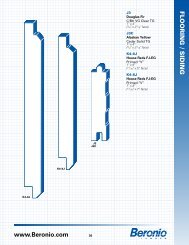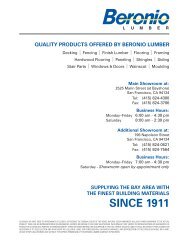Paneling and Siding Catalog - Beronio Lumber
Paneling and Siding Catalog - Beronio Lumber
Paneling and Siding Catalog - Beronio Lumber
You also want an ePaper? Increase the reach of your titles
YUMPU automatically turns print PDFs into web optimized ePapers that Google loves.
38<br />
Selecting the right finish for your wood siding is critical to maintaining<br />
its appearance <strong>and</strong> performance over time. For information beyond<br />
what is presented in this primer on finish types, we recommend The<br />
Forest Products Society's Finishes for Exterior Wood as an excellent<br />
overall guide.<br />
Paints, solid-color stains, clear coatings, water repellents, <strong>and</strong><br />
semitransparent stains are applied to wood siding to enhance its<br />
appearance <strong>and</strong> to protect it from the elements. These <strong>and</strong> other finishes<br />
are classified as either film-forming or penetrating. Both types can be<br />
either water-borne (also known as latex) or oil-base. Upon drying, filmforming<br />
finishes—primers, paints, solid-color stains, <strong>and</strong> clear<br />
coatings—coalesce into a thin continuous sheet that sits on top of the<br />
wood. Of all coating types, film-forming finishes provide the greatest<br />
protection to wood by virtue of the physical barrier they pose to the<br />
elements. Penetrating finishes, on the other h<strong>and</strong>, do not form surface<br />
films, but rather are absorbed into the wood. Water repellents <strong>and</strong><br />
semitransparent stains fall into this category. Effective in controlling<br />
surface checking, penetrating finishes do not stop wood from weathering.<br />
The type of finish, the properties of the wood to which it is applied, local<br />
climate, <strong>and</strong> directional exposure influence the performance <strong>and</strong><br />
longevity of coatings applied to exterior wood products. All other things<br />
being equal, paints last longest, followed closely by solid-color stains,<br />
with semitransparent stains, water repellents, <strong>and</strong> clear coatings all<br />
about an equally distant third. All other things being equal, finishes last<br />
longest on vertical grained surfaces of low density softwoods whose<br />
moisture content stays below about 16 percent. All other things being<br />
FINISHES FOR WOOD SIDING<br />
equal, coatings last longest on a building’s northern exposure <strong>and</strong> on<br />
those parts of a building that are sheltered from rain.<br />
Finishes can be applied to new wood siding in a factory or on site.<br />
Because of its many advantages, factory-finishing of siding is fast<br />
becoming the norm. Here, all sides of every piece of siding—face, back,<br />
edges, <strong>and</strong> ends—are machine-coated with a primer <strong>and</strong>, if desired, with<br />
one or more topcoats. Because the siding arrives at the jobsite already<br />
backprimed <strong>and</strong> topcoated, field finishing costs are reduced or eliminated,<br />
<strong>and</strong> the siding has instant protection from the elements. Site-cut edges<br />
<strong>and</strong> ends, of course, must be re-primed before siding is installed.<br />
Likewise, the back, edges, <strong>and</strong> ends of new bare wood siding that will be<br />
finished in the field should be primed before siding is installed. The face<br />
should be primed within two weeks of the siding being installed,<br />
otherwise it will have to be lightly s<strong>and</strong>ed to remove contaminants <strong>and</strong> to<br />
reactivate the wood for good adhesion. Such surface preparation is, of<br />
course, not possible with roughsawn siding. Best adhesion is achieved on<br />
both smooth <strong>and</strong> rough siding when finishes are worked into surface<br />
irregularities by brushing. Finishes applied on-site by spraying or rolling<br />
should be back-brushed for this reason.<br />
FILM-FORMING FINISHES<br />
PRIMERS—Applied to bare wood in advance of paints <strong>and</strong> solid-color<br />
stains, a primer creates a smooth base for the topcoat to adhere to, <strong>and</strong><br />
serves as a chemical barrier between the wood <strong>and</strong> the topcoat. Best<br />
performance is obtained with a primer that contains a fungicide to stop<br />
mildew <strong>and</strong> a stain-blocker that prevents water-soluble extractives in<br />
wood from discoloring topcoats.




